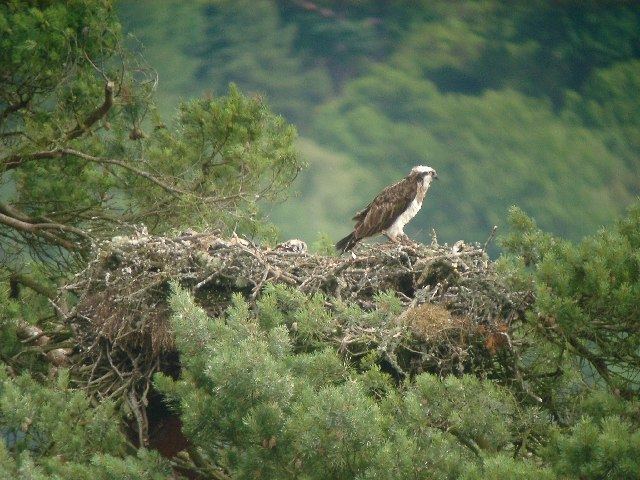 | ||
The osprey (Pandion haliaetus) is a medium large raptor which is a specialist fish-eater with a worldwide distribution. The subspecies Pandion haliaetus haliaetus is native to Eurasia and is found in the British Isles, where it is a scarce breeder primarily in Scotland with smaller numbers in England and Wales. It became extinct in the British Isles in 1916, but recolonised in 1954. Scandinavian birds migrate through Britain on the way to their breeding sites.
Contents
History
The osprey formerly inhabited much of Britain, but heavy persecution, mainly by Victorian egg and skin collectors, during the nineteenth century and early twentieth century brought about its demise. The osprey became extinct as a breeding bird in England in 1840. It is generally considered that the species was absent from Scotland from 1916 to 1954, although there is some evidence it continued to breed in Strathspey in the 1930s and 40s. It is not thought to have inhabited Wales at this time: in Ireland it appears to have died out in the early nineteenth century.
Recolonisation of Scotland
In 1954 Scandinavian birds re-colonised Scotland naturally and a pair has nested successfully almost every year since 1959 at Loch Garten Osprey Centre, Abernethy Forest Reserve, in the Scottish Highlands. The Osprey Centre at Loch Garten has become one of the most well-known conservation sites in the UK and has attracted over 2 million visitors since 1959.
The early re-colonisation was very slow because of contamination of the food chain by organochlorine pesticides and the activities of egg collectors. As a result the breeding population had reached only 14 pairs by 1976. To protect the birds and increase their survival rates, "Operation Osprey" was launched. Barbed wire and electric wires were placed around the trees the birds nested in and a watch was kept over them through the night. Fifteen years later, in 1991, the number of pairs had increased to 71. In 2001, 158 breeding pairs were located, mainly in Scotland. In 2011 RSPB estimated there were between 250 and 300 nesting pairs in Great Britain.
Some chicks from Scottish nests have been moved to England and Spain (Urdaibai Bird Center) to establish new breeding populations.
Reintroduction to England
Because of the slow geographical spread of breeding ospreys within Scotland, in 1996 English Nature and Scottish Natural Heritage licensed a project to re-introduce the osprey to central England. Over six years, chicks from Scottish nests were moved to the Nature Reserve at Rutland Water in the Midlands area, where they were released. Funding was provided by Anglian Water and the Leicestershire and Rutland Wildlife Trust managed the project supported by a large team of volunteers.
In 1999 some of the translocated birds returned after their migration from Africa and in 2001 the first pair bred, including the eponymous Mr Rutland.
Recolonisation of England and Wales
In 1999 a pair from the Scottish population bred for the first time in the Lake District at Bassenthwaite Lake. These two nests were the first recorded in England for 160 years.
Since 2001, pairs of ospreys have continued to breed successfully at both English sites and, by 2007, nineteen osprey chicks had fledged from the Rutland colony. Another unexpected result of the translocation project was the establishment of two nests in Wales in 2004. One was near Welshpool in Montgomeryshire and the other at the RSPB Glaslyn Osprey Project at Pont Croesor, near Porthmadog in north Wales. In both cases the adult male, although originally from Scotland, had been translocated to Rutland. Another significant milestone occurred in 2007 when a female osprey, having fledged from one Rutland nest three years previously, returned as an adult and bred at a second nest. In June 2009 a pair produced three young at Kielder Forest; these are the first to breed at Kielder for over 200 years.
In 2011 the Dyfi Osprey Project reported that an unringed male osprey and a female which fledged from Rutland Water in 2008 had successfully raised chicks at a new nest site near the river Dyfi in Wales. Another pair nested successfully at Kielder.
In 2012 a new nest was reported in Snowdonia, and a single chick hatched successfully.
Viewing and tracking
The websites of the wildlife organisations which protect and manage access to the nest sites at Loch Garten, Rutland Water, WWT Caerlaverock, Scottish Wildlife Trust at Loch of the Lowes and Dyfi, stream live webcam pictures of nesting birds during the breeding season (typically April–September). Loch Garten, Dyfi and the Highland Foundation for Wildlife have fitted satellite trackers to some chicks to improve understanding of migratory behaviour. The exact location of many nests is not widely disclosed due to the risk of eggs being stolen by egg collectors which, despite being made illegal in 1981 under the Wildlife and Countryside Act, continues to present a threat to rare nesting birds.
